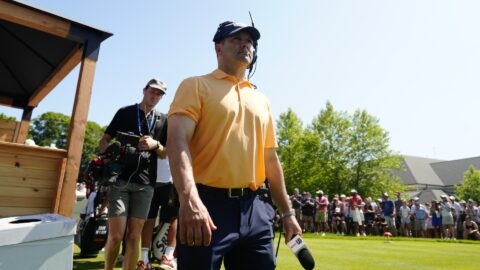The consequences of combining politics with sports could ultimately lead to the PGA Championship being the best major of the golf season.
That's not because of anything that will be said or done this week at Southern Hills Country Club in Tulsa, Oklahoma. Rather, it's the PGA's decision to move this year's tournament from Trump National Golf Club Bedminster to Southern Hills.
That decision, made days after the deadly riot at the U.S. Capitol in 2021, forced the PGA of America to scramble. That led to Southern Hills, which previously hosted the 2007 PGA Championship won by Tiger Woods. Defending champion Phil Mickelson, who finished T-32nd in 2007, won't defend his crown this year.
Southern Hills figures to be a fascinating but truly difficult test for the world's best players. There's plenty of info to unearth for those who are eager to bet on the season's second major or who just want an enriched viewing experience.
Here's a rundown of what we can expect at this week's PGA Championship from Southern Hills CC.
Par: 70
Yardage: 7,365
For starters, it's absolutely stunning.
As this is a return to Southern Hills, which has hosted four PGA Championship tournaments, we are familiar with the course layout. However, a lot of the conversation about the course is centered on how different it is after what renowned golf course architect Gil Hanse labels a "historic renovation" in 2018.
The course will still play long, as evidenced by more than 7,300 yards for a par-70. Part of that renovation included tree removal, which opened up the property allowing for more wind. If the winds blow and the Oklahoma sun bakes the course, it's going to be a very difficult firm-and-fast test.
Unsurprisingly, part of the renovation focused on adding a little more challenge for championship golf. The green complexes are certainly small, placing a premium on ball striking. Making it even more difficult is Hanse and his team also set forth to tighten up the areas around the green. While the extra-long, thick rough we often see at the U.S. Open is a tough test, the same can be said for basically eliminating the rough -- especially with the undulations at Southern Hills. With the tighter cut around the already-small greens, a slight mishit could send a ball rolling back down the fairway if it misses the target.
"I think ultimately it's going to come down to the greens, those small targets," Hanse told The Fried Egg. "In the restoration of the green complexes, we found there was a lot of buildup on the edges … There was a lot of shelf kind of building along the edge of them, so we pulled that all away based on the old photographs that we had seen. Now you have to be incredibly respectful of the edges of the greens because balls are just going to run away."
Not only that, the course is littered with greenside bunkers, surrounding almost every hole, that will put an added emphasis on sand saves and the like.
Troy Martin, who is a longtime caddie and actually produced the Southern Hills yardage books, echoed similar sentiments on "The Pat Mayo Experience" over the weekend. He thinks it's a second-shot golf course, especially if the rough isn't overly long.
"There are several greens that 26, 27, 28 yards deep, which is very small for Tour standards," he said. " … They're very severe around the surroundings. IF you do miss them, it's a difficult up and down. I think it's a second-shot golf course. Even though the length it is what it is, I would favor a strong iron player."
And the challenges around the green, Martin added, will put an added emphasis on the short game.
"You're going to need short-game skills for sure," he told Pat Mayo. " … You could spin it off the green or come up a yard or two short of the green, and you could be 40 or 50 yards away from the green by the time it finishes (rolling)."
Martin currently is on the bag for PGA Tour Champions golfer Stephen Ames, who finished 34th place last year at the Senior PGA Championship, also played at Southern Hills. In the leadup to that tournament, a couple of veteran PGA Tour stars who have made the move to the senior tour weighed in with their thoughts on the track.
Steve Stricker: "I mean, it's a little bit more generous off the tees, but a little bit more demanding into the greens. ... There's a ton of run-off areas now where you really have to be cautious and not short-side yourself and let the ball run sometimes 20, 30 yards away."
Gus Ulrich: "I think it's a second-shot golf course or approach golf course. I mean, you really got to know where to put the ball on the greens and where to try not to miss it. Getting it up and down is a real challenge on some of these greens when you get short-sided. So it's very demanding as far as placing the ball onto the green in the right spot. Off the tee, there's some great tee shots as well. I didn't play here before the redo, but it looks like from what I heard that the fairways have widened quite a bit and they're more generous off the tee. So there's some tee shots that you can go ahead and let it go. And then there's some tee shots you really got to try to hit it right down the middle. But I think overall it's just a really challenging golf course from the second shot in."
Long story short, don't expect a Cinderella to lift the Wanamaker Trophy on Sunday afternoon. Approach play is always key, and it figures to be the biggest factor in determining this tournament. Even then, no one is going to hit every green, so around-the-green play will be needed at some point, which is a potential problem for someone like Viktor Hovland despite his Oklahoma "roots."
It may not be a bomber's paradise, but length will be crucial, too. There's a good deal of similarity to Augusta National, actually, which could be used as a comp course -- especially considering the hilly nature of Southern Hills.
That seems to bode well for Masters champion Scottie Scheffler ... who also happens to consider this his favorite course in the world.



